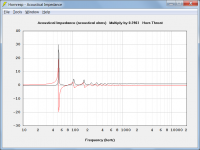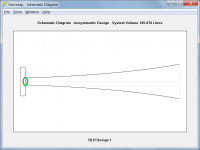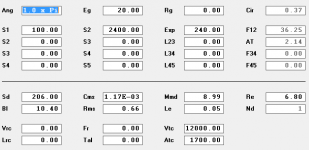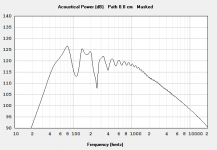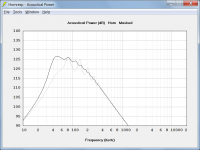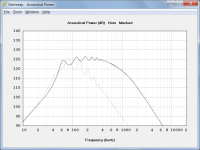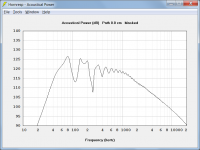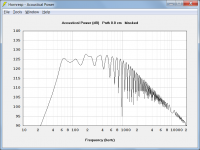Hornresp Update 4030-170305
Hi Everyone,
CHANGE 1
The reference to passive radiator systems in the Loudspeaker Wizard section of the Hornresp Help File has been changed to make it clearer that added mass is specified per radiator. Post #7111 refers.
CHANGE 2
Previously when offset entry point positions were changed in the Multiple Entry Horn Loudspeaker Wizard, the new positions were saved even when the Cancel button was clicked. Changed positions are now only saved when the Save button is clicked.
BUG FIX
The bug identified in Post #7113 and further referenced in Post #7118, has now been fixed.
Kind regards,
David
Hi Everyone,
CHANGE 1
The reference to passive radiator systems in the Loudspeaker Wizard section of the Hornresp Help File has been changed to make it clearer that added mass is specified per radiator. Post #7111 refers.
CHANGE 2
Previously when offset entry point positions were changed in the Multiple Entry Horn Loudspeaker Wizard, the new positions were saved even when the Cancel button was clicked. Changed positions are now only saved when the Save button is clicked.
BUG FIX
The bug identified in Post #7113 and further referenced in Post #7118, has now been fixed.
Kind regards,
David
i get a runtime error 13 type mismatch,when i open the filter wizzard with this file.
older files no probs
ID=39.80
Ang=0.5 x Pi
Eg=77.46
Rg=0.00
Fta=61.89
S1=660.00
S2=660.00
Con=31.10
F12=0.00
S2=660.00
S3=660.00
Con=48.90
F23=0.00
S3=660.00
S4=167.00
Con=0.01
F34=0.00
S4=167.00
S5=357.00
Con=1.80
F45=0.00
Sd=810.00
Bl=18.64
Cms=7.76E-05
Rms=19.82
Mmd=315.70
Le=2.24
Re=3.00
OD=2P
Vrc=177.60
Lrc=62.20
Ap=334.70
Lpt=29.30
Vtc=0.00
Atc=0.00
Pmax=1000
Xmax=19.0
Path=0.0
Mass=0.00
Fr1=0.00
Fr2=0.00
Fr3=0.00
Fr4=0.00
Tal1=100
Tal2=100
Tal3=100
Tal4=100
Comment=b am bass
~~~~~~~~~~~~~~~~~~~~~~~~~~~~~~~~~~~~~~~~~~~~~~~~~~~~~~~~~~~~~~~~~~~~~~~~~~~~~~~~~~~~
FILTER
0.0 0.0 0.0 -1.0 0.0 0.0 0.0 -1.0 0.0 0.0 0.0 -1.0
0.0 0.0 0.0 -1.0 0.0 0.0 0.0 -1.0 0.0 0.0 0.0 -1.0
0 0 0 0
0.50.50.50.5
0.50.50.50.5
SSSS
1111
111
222
1111
111
000
~~~~~~~~~~~~~~~~~~~~~~~~~~~~~~~~~~~~~~~~~~~~~~~~~~~~~~~~~~~~~~~~~~~~~~~~~~~~~~~~~~~~
older files no probs
ID=39.80
Ang=0.5 x Pi
Eg=77.46
Rg=0.00
Fta=61.89
S1=660.00
S2=660.00
Con=31.10
F12=0.00
S2=660.00
S3=660.00
Con=48.90
F23=0.00
S3=660.00
S4=167.00
Con=0.01
F34=0.00
S4=167.00
S5=357.00
Con=1.80
F45=0.00
Sd=810.00
Bl=18.64
Cms=7.76E-05
Rms=19.82
Mmd=315.70
Le=2.24
Re=3.00
OD=2P
Vrc=177.60
Lrc=62.20
Ap=334.70
Lpt=29.30
Vtc=0.00
Atc=0.00
Pmax=1000
Xmax=19.0
Path=0.0
Mass=0.00
Fr1=0.00
Fr2=0.00
Fr3=0.00
Fr4=0.00
Tal1=100
Tal2=100
Tal3=100
Tal4=100
Comment=b am bass
~~~~~~~~~~~~~~~~~~~~~~~~~~~~~~~~~~~~~~~~~~~~~~~~~~~~~~~~~~~~~~~~~~~~~~~~~~~~~~~~~~~~
FILTER
0.0 0.0 0.0 -1.0 0.0 0.0 0.0 -1.0 0.0 0.0 0.0 -1.0
0.0 0.0 0.0 -1.0 0.0 0.0 0.0 -1.0 0.0 0.0 0.0 -1.0
0 0 0 0
0.50.50.50.5
0.50.50.50.5
SSSS
1111
111
222
1111
111
000
~~~~~~~~~~~~~~~~~~~~~~~~~~~~~~~~~~~~~~~~~~~~~~~~~~~~~~~~~~~~~~~~~~~~~~~~~~~~~~~~~~~~
Last edited:
i get a runtime error 13 type mismatch,when i open the filter wizzard with this file.
Hi epa,
Thanks for the feedback - I experience the same problem.
I need to investigate...
Kind regards,
David
Hello,
So I posted about a week ago regarding having someone look over my data to see if it makes sense.
After spending some time fiddling in Hornresp I have just found that the Bass Reflex would be the best option. Are the curves actually this dramatic in real life?
I was expecting a BLH enclosure to be best considering that is what Fostex recommends.
Any help at all on this would be greatly appreaciated.
Craig
So I posted about a week ago regarding having someone look over my data to see if it makes sense.
After spending some time fiddling in Hornresp I have just found that the Bass Reflex would be the best option. Are the curves actually this dramatic in real life?
I was expecting a BLH enclosure to be best considering that is what Fostex recommends.
Any help at all on this would be greatly appreaciated.
Craig
Attachments
Hornresp Update 4030-170307
Hi Everyone,
The bug reported by epa in Post #7122 has now been fixed.
Some of the filter parameter values were being incorrectly saved to the export file, which meant that they were also incorrect when imported back as a new record, causing a fatal error when the Filter Wizard was called.
Unfortunately the only way to fix an existing corrupted imported record is to add a copy of the default record and then manually re-enter the input parameter values from the corrupted record into the new copy of the default record. Once this is done the old corrupted record and related corrupted import text file should both be deleted to avoid the possibility of any future problems.
Kind regards,
David
Hi Everyone,
The bug reported by epa in Post #7122 has now been fixed.
Some of the filter parameter values were being incorrectly saved to the export file, which meant that they were also incorrect when imported back as a new record, causing a fatal error when the Filter Wizard was called.
Unfortunately the only way to fix an existing corrupted imported record is to add a copy of the default record and then manually re-enter the input parameter values from the corrupted record into the new copy of the default record. Once this is done the old corrupted record and related corrupted import text file should both be deleted to avoid the possibility of any future problems.
Kind regards,
David
i get a runtime error 13 type mismatch,when i open the filter wizzard with this file.
Hi epa,
A repaired copy of your export / import file is attached. It should now work okay with the Filter Wizard.
Thanks again for the valuable feedback.
Kind regards,
David
Attachments
After spending some time fiddling in Hornresp I have just found that the Bass Reflex would be the best option. Are the curves actually this dramatic in real life?
I was expecting a BLH enclosure to be best considering that is what Fostex recommends.
Hi Craig,
The three BLH designs you show all have relatively small mouths for the horn flare cutoff frequencies being used. This means that the throat impedances will be very peaky, resulting in the response curves you are seeing. Attachment 1 shows the throat acoustical impedance for the Fostex recommended BLH.
BLH Design 1 and BLH Design 2 have unrealistically small "pinched" throats (Ap1 = 1 cm^2 in each case). Attachment 2 shows the schematic diagram for BLH Design 1.
You have specified the Infinite Baffle design as a closed-box loudspeaker radiating into quarter space (Ang = 1 x Pi).
If you want to simulate a true infinite baffle, set Ang = 2 x Pi.
Use the Directivity tool if you would like to see the pressure response rather than the power response of the direct radiator Infinite Baffle design.
Kind regards,
David
Attachments
Hi David,
First off, thank you so much for replying, its rare to get such good feedback with something technical.
So have I not modelled the recommended BLH enclosure correctly?
I don't really understand the flare cut-off frequency issue as I thought this value was fixed if you have set the mouth, throat and length values? But I understand that a flare cut-off frequency of apx 30Hz is unrealistic.
Smaller throat gives the results attached. Is that not still very "peaky"?
Any help from anyone is again much appreciated!
Craig
First off, thank you so much for replying, its rare to get such good feedback with something technical.
So have I not modelled the recommended BLH enclosure correctly?
I don't really understand the flare cut-off frequency issue as I thought this value was fixed if you have set the mouth, throat and length values? But I understand that a flare cut-off frequency of apx 30Hz is unrealistic.
Smaller throat gives the results attached. Is that not still very "peaky"?
Any help from anyone is again much appreciated!
Craig
Attachments
excelentHi epa,
A repaired copy of your export / import file is attached. It should now work okay with the Filter Wizard.
Thanks again for the valuable feedback.
Kind regards,
David
The bug reported by epa in Post #7122 has now been fixed.
Greets!
FWIW, I've had AVAST! AV freeware for many years now with no issues I can recall with any audio design software, but this latest revision was locked out, removed from the START program and 'submitted' for review, though ultimately did give me the option to go into settings to allow it, then 'admonished' me for 'gambling' anyway.
GM
FWIW, I've had AVAST! AV freeware for many years now with no issues I can recall with any audio design software, but this latest revision was locked out, removed from the START program and 'submitted' for review, though ultimately did give me the option to go into settings to allow it, then 'admonished' me for 'gambling' anyway.
Hi GM,
I suspect in this case that you happened to be an "early downloader", and that your antivirus software detected that the new version of the Setup.exe file had only been downloaded a few times prior to your copy being downloaded.
This happens to me quite often with my Norton Internet Security software when I download a copy of a new release immediately after having uploaded it, to check that everything is working okay. The Norton software tells me that the file has been downloaded less than five times, and asks me if I want to proceed. It appears to think that because the file has only been downloaded a few times (at that stage) that it might be suspect.
Kind regards,
David
Hi Craig,
I think that you have probably modelled the Fostex recommended BLH okay - it's just that it appears to be a significantly compromised design to begin with. Because the mouth size is relatively small, the resultant impedance mis-match at that point causes significant reflections, making the duct act more like a resonant tube than a horn. The resonant behaviour can be seen quite clearly in the throat acoustical impedance chart results I posted earlier.
For your exponential horn example with S1 = 100, S2 = 2400 and L12 (Exp) = 240, the cutoff frequency F12 is given by:
F12 = c * Ln(S2 / S1) / (4 * Pi * L12)
where c = velocity of sound in air (assumed to be 34400 cm/sec)
Therefore:
F12 = 34400 * Ln(2400 / 100) / (4 * Pi * 240) = 36.25 Hz
Your revised design has the throat constriction removed, but the fundamental problem still remains - the mouth size of 2400 cm^2 is really too small for a horn with a cutoff frequency of 36.25 Hz radiating into quarter space. The value of Cir is 0.37 - ideally this should be closer to 1 to reduced the ripples in the response to more acceptable levels.
To illustrate, the grey trace in the attachment shows the horn output for your revised design. The black trace shows the output for a horn having the same throat size and cutoff frequency as your revised design, but extended in length until the value of Cir = 1.
That is:
S1 = 100.00
S2 = 17915.59
L12 (Exp) = 391.80
F12 = 36.25
Cir = 1.00
Kind regards,
David
So have I not modelled the recommended BLH enclosure correctly?
I think that you have probably modelled the Fostex recommended BLH okay - it's just that it appears to be a significantly compromised design to begin with. Because the mouth size is relatively small, the resultant impedance mis-match at that point causes significant reflections, making the duct act more like a resonant tube than a horn. The resonant behaviour can be seen quite clearly in the throat acoustical impedance chart results I posted earlier.
I don't really understand the flare cut-off frequency issue as I thought this value was fixed if you have set the mouth, throat and length values?
For your exponential horn example with S1 = 100, S2 = 2400 and L12 (Exp) = 240, the cutoff frequency F12 is given by:
F12 = c * Ln(S2 / S1) / (4 * Pi * L12)
where c = velocity of sound in air (assumed to be 34400 cm/sec)
Therefore:
F12 = 34400 * Ln(2400 / 100) / (4 * Pi * 240) = 36.25 Hz
Smaller throat gives the results attached. Is that not still very "peaky"?
Your revised design has the throat constriction removed, but the fundamental problem still remains - the mouth size of 2400 cm^2 is really too small for a horn with a cutoff frequency of 36.25 Hz radiating into quarter space. The value of Cir is 0.37 - ideally this should be closer to 1 to reduced the ripples in the response to more acceptable levels.
To illustrate, the grey trace in the attachment shows the horn output for your revised design. The black trace shows the output for a horn having the same throat size and cutoff frequency as your revised design, but extended in length until the value of Cir = 1.
That is:
S1 = 100.00
S2 = 17915.59
L12 (Exp) = 391.80
F12 = 36.25
Cir = 1.00
Kind regards,
David
Attachments
Hi GM,
I suspect in this case that you happened to be an "early downloader", and that your antivirus software detected that the new version of the Setup.exe file had only been downloaded a few times prior to your copy being downloaded.
Greets!
Thanks! Hmm, added it to this LT apparently on 2/1/16 and have [15] updates in the Trash Bin including this one, so really slow to protect me from myself if this is the case.
Oh well, it is freeware........
GM
Your revised design has the throat constriction removed, but the fundamental problem still remains - the mouth size of 2400 cm^2 is really too small for a horn with a cutoff frequency of 36.25 Hz radiating into quarter space.
Something else to perhaps consider.
The horn throat chamber acts as an acoustic low pass filter. The volume Vtc used in the revised design is 12 litres, which severely attenuates the horn response above about 150 Hz. I am not sure if this is intentional or not. The grey trace in the attachment shows the horn output for the original revised design. The black trace shows the output for the same horn, but with the throat chamber reduced in size.
Grey trace:
Vtc = 12000
Atc = 1700
Black trace:
Vtc = 500
Atc = 206 (same as Sd)
Attachments
Oh well, it is freeware........
So is Hornresp - and it can be a bit 'flaky' too, from time to time 🙂.
Hornresp.com
Hi Everyone,
I have recently been advised that Hornresp can now be downloaded using either 'www.hornresp.net' or 'www.hornresp.com' as the website address. My sincere thanks to Sabbelbacke for arranging the alternative '.com' domain name, and for his ongoing generous support in continuing to host Hornresp for us all.
Kind regards,
David
Hi Everyone,
I have recently been advised that Hornresp can now be downloaded using either 'www.hornresp.net' or 'www.hornresp.com' as the website address. My sincere thanks to Sabbelbacke for arranging the alternative '.com' domain name, and for his ongoing generous support in continuing to host Hornresp for us all.
Kind regards,
David
Something else to perhaps consider.
The horn throat chamber acts as an acoustic low pass filter. The volume Vtc used in the revised design is 12 litres, which severely attenuates the horn response above about 150 Hz. I am not sure if this is intentional or not. The grey trace in the attachment shows the horn output for the original revised design. The black trace shows the output for the same horn, but with the throat chamber reduced in size.
Grey trace:
Vtc = 12000
Atc = 1700
Black trace:
Vtc = 500
Atc = 206 (same as Sd)
In the case of a back loaded horn the 150 hertz lowpass is a good thing. (Pretty sure David knows this) If it was intentional great work. If it was an accident then it will still work. Nothing is worse for imaging than having two very widely spaced sources of midrange content that are out of phase.
In the case of a back loaded horn the 150 hertz lowpass is a good thing. Nothing is worse for imaging than having two very widely spaced sources of midrange content that are out of phase.
Attachment 1 shows the predicted combined power response with the original throat chamber, Attachment 2 with the smaller chamber.
As expected, interference effects above about 400Hz are significant in the second trace.
Attachments
- Home
- Loudspeakers
- Subwoofers
- Hornresp
